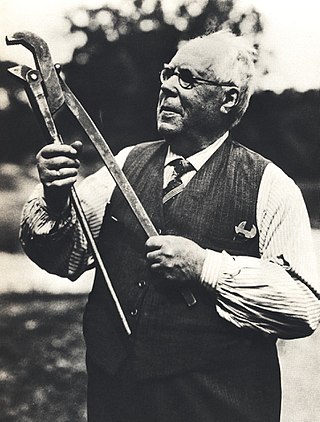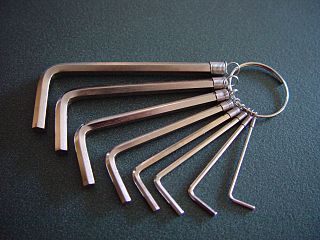
A wrench or spanner is a tool used to provide grip and mechanical advantage in applying torque to turn objects—usually rotary fasteners, such as nuts and bolts—or keep them from turning.

A monkey wrench is a type of smooth-jawed adjustable wrench, a 19th century American refinement of 18th-century English coach wrenches. It was widely used in the 19th and early 20th century. It is of interest as an antique among tool collectors and is still occasionally used in practice.

Pliers are a hand tool used to hold objects firmly, possibly developed from tongs used to handle hot metal in Bronze Age Europe. They are also useful for bending and physically compressing a wide range of materials. Generally, pliers consist of a pair of metal first-class levers joined at a fulcrum positioned closer to one end of the levers, creating short jaws on one side of the fulcrum, and longer handles on the other side. This arrangement creates a mechanical advantage, allowing the force of the grip strength to be amplified and focused on an object with precision. The jaws can also be used to manipulate objects too small or unwieldy to be manipulated with the fingers.

Johan Petter Johansson, sometimes known as JP, was a Swedish inventor and industrialist. He invented a modern adjustable spanner. He obtained over 100 patents in total.

A pipe wrench is any of several types of wrench that are designed to turn threaded pipe and pipe fittings for assembly (tightening) or disassembly (loosening). The Stillson wrench, or Stillson-pattern wrench, is the usual form of pipe wrench, especially in the US. The Stillson name is that of the original patent holder, who licensed the design to a number of manufacturers; the patent has since expired decades ago. A different type of wrench with compound leverage often used on pipes, the plumber wrench, is also called a "pipe wrench" in some places.

A socket wrench is a type of spanner that uses a closed socket format, rather than a typical open wrench/spanner to turn a fastener, typically in the form of a nut or bolt.

A chuck is a specialized type of clamp used to hold an object with radial symmetry, especially a cylinder. In a drill, a mill and a transmission, a chuck holds the rotating tool; in a lathe, it holds the rotating workpiece.
British Standard Whitworth (BSW) is an imperial-unit-based screw thread standard, devised and specified by Joseph Whitworth in 1841 and later adopted as a British Standard. It was the world's first national screw thread standard, and is the basis for many other standards, such as BSF, BSP, BSCon, and BSCopper.

A vise or vice is a mechanical apparatus used to secure an object to allow work to be performed on it. Vises have two parallel jaws, one fixed and the other movable, threaded in and out by a screw and lever.

A plumber wrench is a form of plier described as a pipe wrench that uses compound leverage to grip and rotate plumbing pipes. Similar to the action of a Vise Grip plier, its jaw opening is adjusted to width by rotating a threaded ring. Its advantage is that it grips with significant force without needing to engage a lock nut like an adjustable tongue-and-groove plier. Like these, it can also be used on nuts, particularly hex shaped, and other flat engagement points. If used carelessly it can dent or break plumbing pipe.

Locking pliers are pliers that can be locked into position, using an "over-center" cam action. Locking pliers are available with many different jaw styles, such as needle-nose pliers, wrenches, clamps and various shapes to fix metal parts for welding. They also come in many sizes.

A screw and a bolt are similar types of fastener typically made of metal and characterized by a helical ridge, called a male thread.

A nut is a type of fastener with a threaded hole. Nuts are almost always used in conjunction with a mating bolt to fasten multiple parts together. The two partners are kept together by a combination of their threads' friction, a slight stretching of the bolt, and compression of the parts to be held together.

Tongue-and-groove pliers are a type of slip-joint pliers. They are also known as:

Bahco is a Swedish brand within the hand tool industry, which is now part of SNA Europe, part of Snap-on. Its roots go back to the industrial revolution in Sweden in the late eighteen hundreds, starting with innovations such as the pipe wrench and the modern adjustable wrench. Since then, the product range has expanded with a total assortment of products that today includes over 7000 hand tools.

A bolt is a form of threaded fastener with an external male thread requiring a matching pre-formed female thread such as a nut. Bolts are very closely related to screws.

Allen is a brand of hand tools, most widely recognized for its wrenches, known generically as "Allen wrenches". As a brand, it is owned by Apex Tool Group.

A hex key is a simple driver for bolts or screws that have heads with internal hexagonal recesses (sockets).

Width across flats is the distance between two parallel surfaces on the head of a screw or bolt, or a nut, mostly for torque transmission by positive locking.

























